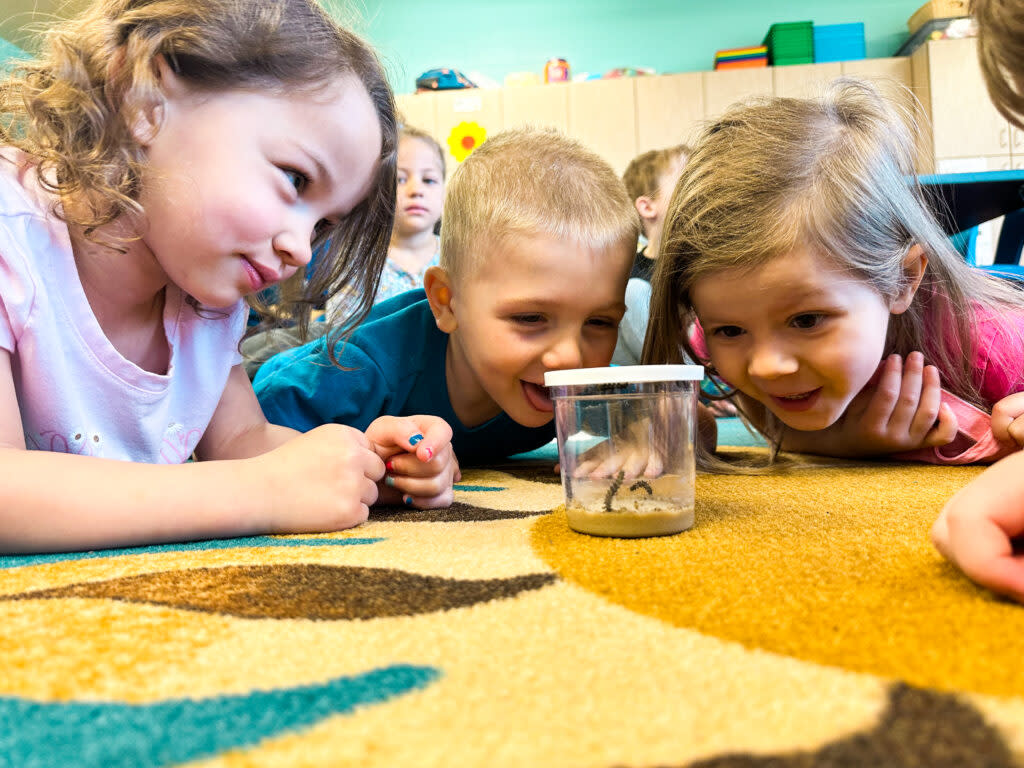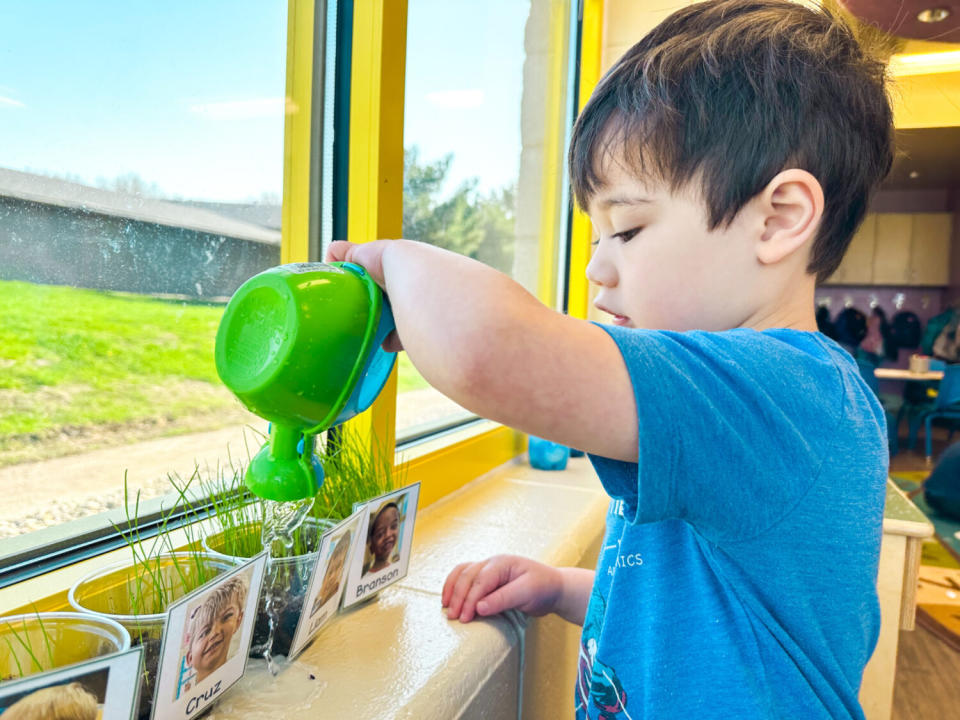Cities and schools see new opportunities to partner on child care with state grants

Brookings children watch caterpillars grow at the local Boys and Girls Club. (Courtesy of the Boys and Girls Club of the Northern Plains)
Jody Hernandez has a pitch for Brookings businesses to support a child care initiative in the city.
“We can go to employers and say, if you want to retain employees, then we have a system that their potential employees’ children from ages 0 to 5 can be kept safe with a great education from 6 a.m. to 6 p.m.,” said Hernandez, who serves as CEO of the Boys and Girls Club of the Northern Plains.
She was referring to a new collaboration between the Boys and Girls Club and the Brookings School District. The nonprofit will create three club sites at elementary schools in Brookings to offer preschool and child care for the entire workday.
Second in a series
This is the second of three stories about the ways communities are utilizing child care grants from the state. The first story examined how small towns are using the grants, and the next will examine how the state’s two largest cities are thinking creatively.
The club will use school facilities and a shared curriculum to help prepare 4- and 5-year-olds for kindergarten in a structured environment similar to what they’ll experience in school.
The collaboration provides continuous care for preschoolers, rather than a half-day model, and it isn’t tied to public education. Instead, it’s starting out as a fee-based model where the school district provides the facilities and the Boys and Girls Club covers the rest of the children’s needs.
The move will open up the Boys and Girls Club’s current facility to double the number of 3-year-olds the club can provide preschool and continuous care for. The nonprofit also plans to remodel the facility and partner with another child care provider to serve children up to 2 years old. Hernandez said the nonprofit is partnering with the Children’s Museum and South Dakota State University to create a “fun, interactive design” for the space.
Hernandez hopes the collaboration will open 100 new 0-2 child care spots in the Brookings area by 2025 and serve up to 240 children at the school district club sites. While Brookings has four child care centers, two are associated with an employer and primarily serve employees’ children, which limits community options for child care, she said.

A child waters plants at the Boys and Girls Club in Brookings. (Courtesy of the Boys and Girls Club of the Northern Plains)
Brookings is one of 13 communities awarded a child care grant from the Governor’s Office of Economic Development last month. In total, the grants, using federal funds, are infusing over $3.7 million into helping communities find collaborative, innovative solutions to address child care needs across South Dakota.
The initiatives range from improving the child care workforce, to creating after-school programs, to supporting existing providers with continued education. The Brookings partnership was awarded $400,000 for its program.
“It just made sense that we’d work hand in hand with the school district on this program,” Hernandez said, saying the partnership will help children transition to school more easily, especially with a focus on early literacy. “In 18 years we’ll see the success we’ve got from this program. When they graduate from school, hopefully they’ll have handled school better, performed better and will become adults that’ll give back to their community.”
Brookings isn’t the only community that sees a partnership between child care providers and the local school district as a potential solution to addressing child care shortages:
Burke will launch its first after-school program in collaboration with the school district with its $211,000 grant.
Mobridge will hold privately funded preschool classes and child care inside its school buildings with its $500,000 grant.
Vermillion’s school district gifted an empty elementary school to child care providers to use.
Mobridge preschool model
Michele Harrison, executive director for the Mobridge Chamber of Commerce in north-central South Dakota, said the town’s lone licensed child care facility has a waitlist of over 35 children. Many of the child care spots are filled by 3- and 4-year-olds rather than younger children.
“I have employers on my board who’ve been screaming at me for a long time to do something about day care, because they can’t have employees without it,” Harrison said.
Similar to Brookings, the local child care center, after-school program and school district are partnering to provide fee-based preschool and child care for 3- and 4-year-olds across the street from the school. The school’s tech class will build two classrooms on the currently vacant lot, Harrison said.
Additionally, the future child care program, called Lake Oahe Learning Academy, will work as an umbrella organization to help in-home child care providers become licensed, answer their questions and provide support.
Harrison said Mobridge will gain 18 infant and toddler slots as well as 34 preschool-age slots by the start of the school year in the fall. She plans to have 16 more infant and toddler slots available by fall 2025.
Creating after-school programs in rural areas
Gregory County, in south-central South Dakota, doesn’t have any licensed after-school or summer care programs, said Kelsea Sutton, president of the Burke Business Promotion Council. Those students, similar to Mobridge, end up filling needed child care slots for younger children and infants. It can also impact productivity in the county.
“I don’t think families here understand how much they’ve rearranged their lives to accommodate the lack of after-school care,” Sutton said. “Whether that’s a grandparent reducing their work hours to take care of their grandkids after school, a parent doing that, or even a family making not the best or safest decision so they can have a full work day.”
The plan is to run an after-school care program through the three licensed child care facilities in the county – in Burke, Gregory and Bonesteel — since the requirements for licensing a child care center are similar to after-school care. But the programs themselves will be hosted on school campuses.
The program will be fee-based, but Sutton is encouraging eligible families to enroll their children using the state’s child care assistance program because it “helps providers be sustainable.” The after-school program can serve up to 90 children.
Platte, using its nearly $300,000 grant, is planning to create an after-school program at an existing child care center in the town. The town, across the Missouri River from Gregory County, doesn’t have an after-school program.
The community’s original plan was to create a school-adjacent after-school program by relocating another child care provider to a former assisted living facility, said Colette Mesman, executive director for the Platte Development Corporation, but that plan fell through.
The money will now be used to expand capacity at the child care facility to accommodate over 20 more children and to help the provider recruit and retain more employees for the expanded program. Mesman said the grant will be used to offer sign-on and retention bonuses.
“It’s still great,” Mesman said. “It’s a smaller impact than what we planned, but we’re still utilizing the money to impact child care in Platte.”
Vermillion School District donates building, uses grant to expand access and workforce
In Vermillion, the city is looking to increase child care slots by 46 by using an old elementary school building for a child care center, and by using grant money to renovate the school building and a couple of other child care centers.
The school district donated the building to the Vermillion Boys and Girls Club, but the center will be run by another child care provider.
The city also plans to build a preschool science, technology, engineering, arts and mathematics (STEAM) lab for preschoolers, establish a voucher system for businesses to buy slots in child care throughout Vermillion, and help improve the child care workforce by paying for certification for child care workers, said President and CEO of the Vermillion Area Chamber and Development Company Jim Peterson.
Peterson hopes the initiatives will set an example for other South Dakota communities. He added that the University of South Dakota will work with child care providers to research and assess the impact of the proposed STEAM lab, which will be available for providers across the state to access.
“We really tried to look at the model overall and make it sustainable over the long term,” Peterson said. “Based on the study and need and looking at the workforce demands in Vermillion, our group felt this was the best utilization of the grant and gives the best return on the feedback we got from parents and businesses. It hits on accessibility, affordability, quality and getting more teachers into the workforce.”
GET THE MORNING HEADLINES DELIVERED TO YOUR INBOX
The post Cities and schools see new opportunities to partner on child care with state grants appeared first on South Dakota Searchlight.

